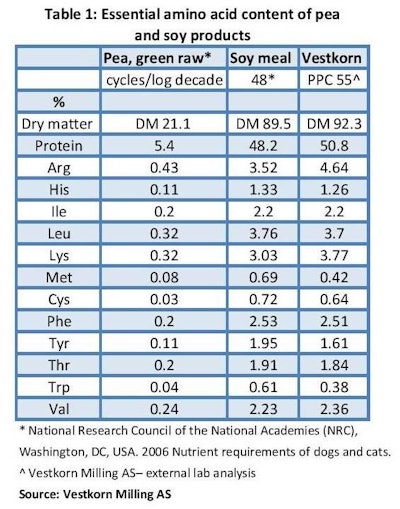
Pea starches and proteins have been used in petfood for many years, but there is a growing interest in their use. One driver has been the rapid growth of non-grain petfoods, initially in the US but now spreading to Europe and elsewhere. Yellow or green peas (Pisum sativum) are considered legume pulses, like soybeans, and they share some nutritional and functional properties. Several products are prepared from peas with several applications in a range of petfoods and treats.
Whole peas have almost 25% protein on a dry matter basis, along with starch, fiber and a small amount of oils. Through mechanical processing only—dry milling of peas followed by air classification—different pea products are made, with the most important being pea protein concentrate, pea flour (pea starch) and pea fiber (see Figure 1).
Pea protein concentrate has a similar protein level to soybean meal, and so can be a good substitute. It is also a non-GM product. Table 1 compares the amino acid profile of peas and soybean meal. Pea protein is especially rich in lysine, and the amino acid distribution is not unlike soybeans.
Peas are also a good natural source of vitamin A, thiamine, niacin, vitamin B6, folate, vitamin K, copper, zinc and manganese. Peas contain carotenoids and other known cell antioxidants (Troszyńska et al., 2002). Like soybeans, peas contain some anti-nutrient factors including phytic acid, lectins, saponins and gas-generating oligosaccharides including raffinose and stacchyose. Many of these compounds are neutralized during cooking and are only present in some pea fractions. There has been almost no published information on either beneficial nutrients or anti-nutrients in peas for petfoods, but peas and pea products are considered safe at 50% or more of a petfood recipe (Aldrich 2011).
Pea flour typically contains about 60% starch, 12% protein and 2.7% crude fiber, a similar basic profile to wheat. This makes pea flour an ideal substitute in no-grain petfoods, and the protein content is helpful if used alongside low protein starches such as potato or sweet potato. Using pea flour may require some adjustment of processing conditions, but modern extruders can give an excellent final product texture (Sørensen 2011).
Information on palatability of finished products is limited, but published reports suggest it feeds well, and pea flour is quite bland in aroma (Aldrich 2010). Pea starch digestibility has been measured for dogs and cats (Carciofi et al., 2008; de-Oliveira et al., 2008). With a 35% starch content, digestibility was a little lower than for brewer’s rice in both species, but they still reported high values above 98% and 96%, respectively.
Pea starch has useful functional properties for a range of extruded products including treats, where they offer innovative options for texture and nutrition. Pea protein has structural extrusion properties and, using the correct extrusion parameters, will give protein cross-linkage for texturized meat-looking protein chunks, similar to soy or gluten.
Pea flour is a good grain-free alternative to wheat or maize flour for steam oven-baked chunks. Starch has a useful function in meaty chunks as it absorbs water, improving appearance and structure. Cereal starch may leach out of chunks and give a cloudy sauce or gel, or else may settle out as a pasty mass. Pea starch has different properties, such as a higher gel strength, that may improve visual aspects.
Pea proteins have functional properties including solubility, water and fat binding capacity comparable to other frequently used proteins such as soy and whey (Boye et al., 2010). Pea protein concentrate is a possible alternative to wheat gluten or other non-meat binders used to help meat proteins make chunks solid.
Fiber in peas has a relatively high level of insoluble fiber, which can help provide a feeling of fullness and aid passage of food through the diet.
Peas are a versatile ingredient for petfoods with many attractive features. Their grain- and GM-free status, good functional and nutritional properties along with good future availability mean they are a worthwhile ingredient for petfood companies to investigate and use.















